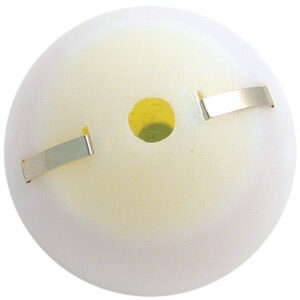January 7, 2010
 by: Ellen Lewis
by: Ellen Lewis
A Toroidal Vortex is whirling air or liquid in the shape of a doughnut. Vortices are created in nature by many things including dolphins, volcanoes, tornadoes, hurricanes, and whirlpools. They can be created around the wings of an airplane, in the wake of a boat, or in a rocket blast. Now you can make Toroidal Vortices in your classroom with the Zero Blaster and the Air Zooka. Use these products to discuss friction, pressure, the Bernoulli Effect, or the Coanda Effect.
Activity 1: A Simple Toroidal Vortex
Create a simple Toroidal Vortex with a droplet of food coloring and a tall glass of water. Start by holding the dropper about 3 cm above the water’s surface. Squeeze a single drop of food coloring straight down into the glass. You will be amazed to see how the friction between the water and the food coloring will create the doughnut shaped rings! Read the rest of this entry »
 Leave a Comment » |
Leave a Comment » |  experiments, High School level, Middle School level, Physics | Tagged: Bernoulli Effect, Coanda effect, torodial vorticies, vortex |
experiments, High School level, Middle School level, Physics | Tagged: Bernoulli Effect, Coanda effect, torodial vorticies, vortex |  Permalink
Permalink
 Posted by Tami O'Connor
Posted by Tami O'Connor
December 30, 2009
 by: Sarah Brandt
by: Sarah Brandt
The uniquely entertaining energy ball is a fun way to demonstrate open and closed circuits, as well for prompting discussions on conductivity. The following activities are perfect to use in elementary and middle school grades first exploring electricity and circuits.
When both sensors on the ball are touched and a complete circuit is formed, the ball flashes a red light and buzzes.
What makes the energy ball work?

Inside the energy ball is a simple circuit that is completely self-contained. By touching both sensors, the circuit is completed by electrons flowing through your body or another conductive material such as a paper clip. Materials that activate the energy ball
are good conductors, meaning they pass electrons easily. Materials that do not activate the energy ball are poor conductors (or insulators), meaning they do not pass electrons easily. Read the rest of this entry »
 4 Comments |
4 Comments |  Elementary level, energy, experiments, Middle School level | Tagged: closed circuits, electricity, open circuits, phenomenon based learning, STEM |
Elementary level, energy, experiments, Middle School level | Tagged: closed circuits, electricity, open circuits, phenomenon based learning, STEM |  Permalink
Permalink
 Posted by Tami O'Connor
Posted by Tami O'Connor
December 30, 2009
 by: Tami O’Connor
by: Tami O’Connor
One of the units I enjoyed most as a middle school teacher was the section on energy. The many awesome hands-on experiments generated such a series of oohs and aahs that it made my already-enjoyable days even more enjoyable! One of my favorites was a lesson that dealt with the Law of Conservation of Energy. A consequence of this law is that energy cannot be created, nor can it be destroyed. (The students would have already explored potential and kinetic energy before the following activity.)
I initiated this lesson reviewing what happens with energy in a closed system. The students clearly remembered comparing the amount of potential energy to kinetic energy using the example that the height of a roller coaster’s first hill is always greater than the height of any of the remaining hills. It is, of course, possible to have a little hill followed by a higher hill as long as the roller coaster is going faster at the top of the little hill than the next higher one. The students were generally able to explain the transfer of energy including heat energy and sound energy in the overall system.
Read the rest of this entry »
 8 Comments |
8 Comments |  energy, experiments, Middle School level, Physics | Tagged: discrepant event, kinetic energy, Law of Conservation of Energy, parent friendly, phenomenon based learning, potential energy |
energy, experiments, Middle School level, Physics | Tagged: discrepant event, kinetic energy, Law of Conservation of Energy, parent friendly, phenomenon based learning, potential energy |  Permalink
Permalink
 Posted by Tami O'Connor
Posted by Tami O'Connor
December 1, 2009
 by Tami O’Connor
by Tami O’Connor
Invented in 1945 by Miles Sullivan, the “drinking bird” has been a favorite of science teachers in every classroom from kindergarten through college. This amazing device is made of two glass bulbs (one representing the head and the other representing the body) joined by a glass tube (representing the neck). Between the two bulbs, attached to the glass tube, is a metal fulcrum upon which the bird pivots. The air has been removed from this closed device, and the bottom ball is filled with a colored liquid that has a high vapor pressure (methylene chloride). The rest of the bird’s body and head is filled with the vapor form of methylene chloride.
Read the rest of this entry »
 1 Comment |
1 Comment |  Chemistry, College level, Elementary level, energy, experiments, High School level, Middle School level, Physics | Tagged: drinking bird, evaporation, parent friendly, perpetual motion, phenomenon based learning, thermal energy, vapor pressure |
Chemistry, College level, Elementary level, energy, experiments, High School level, Middle School level, Physics | Tagged: drinking bird, evaporation, parent friendly, perpetual motion, phenomenon based learning, thermal energy, vapor pressure |  Permalink
Permalink
 Posted by Tami O'Connor
Posted by Tami O'Connor
November 13, 2009
 by: Ron Perkins
by: Ron Perkins
Ultraviolet detecting beads contain pigments that change color when exposed to ultraviolet light from the sun or certain other UV sources. The electromagnetic radiation needed to affect change is between 360 and 300 nm in wavelength. This includes the high-energy part of UV Type A (400-320 nm) and the low energy part of UV Type B (320-280 nm). Long wave fluorescent type black lights work well; incandescent black lights and UV-C lamps will not change the color of the beads.
The dye molecules consist of two large, planar, conjugated systems that are orthogonal to one another. No resonance occurs between two orthogonal parts of a molecule. Imagine two planes at right angles to one another, connected by a carbon atom. When high energy UV light excites the central carbon atom, the two smaller planar conjugated parts form one large conjugated planar molecule. Read the rest of this entry »
 5 Comments |
5 Comments |  Chemistry, energy, High School level | Tagged: blacklights, ultraviolet |
Chemistry, energy, High School level | Tagged: blacklights, ultraviolet |  Permalink
Permalink
 Posted by Tami O'Connor
Posted by Tami O'Connor
 by: Ellen Lewis
by: Ellen Lewis


 Posted by Tami O'Connor
Posted by Tami O'Connor  by: Sarah Brandt
by: Sarah Brandt
 by: Tami O’Connor
by: Tami O’Connor